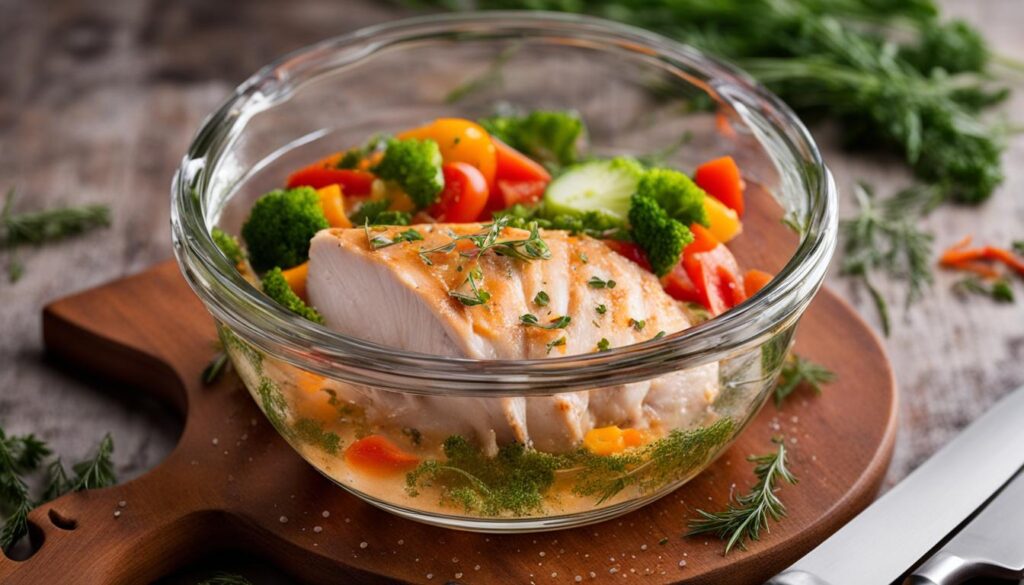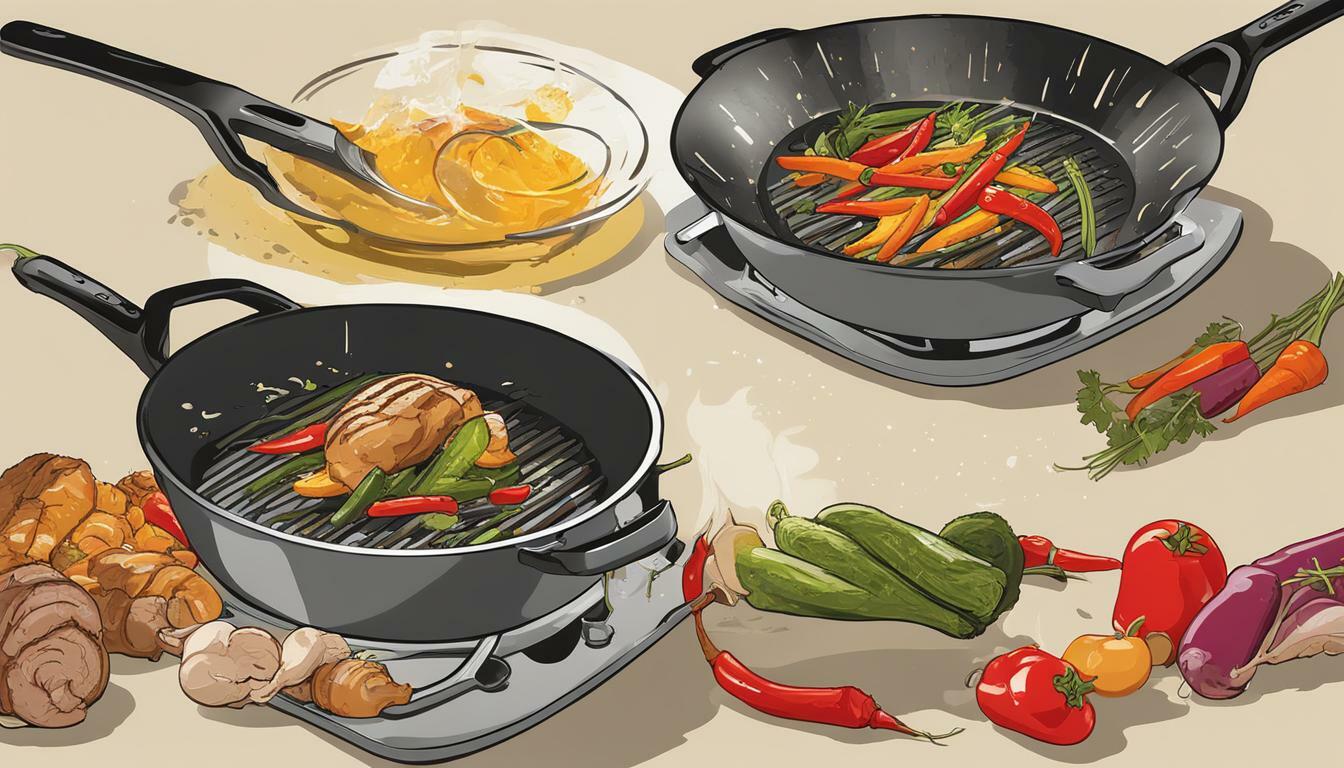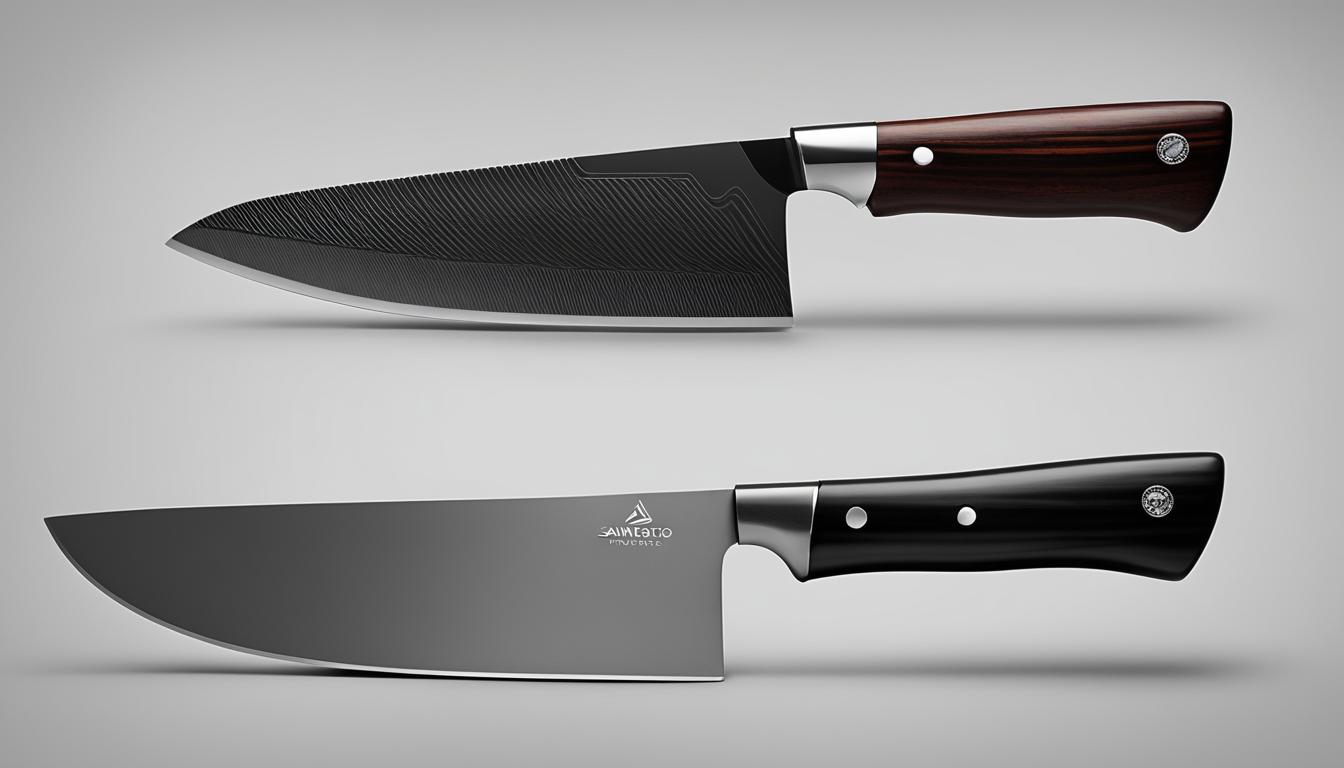Enhancing flavors in cooking is an art that involves various techniques. Two popular methods used to elevate the taste of meat are marinating and brining. Although both techniques utilize salt, they serve different purposes and yield distinct results. In this article, we will explore the difference between marinating and brining and how each technique enhances the flavor and texture of meat.
Key Takeaways:
- Marinating is used to infuse flavor into meat, while brining is used to lock in moisture and make the meat juicier.
- Brining involves soaking meat in a saltwater solution, while marinating involves marinating the meat in a mixture containing acid.
- Both marinating and brining have unique benefits and can be used in various cooking applications.
- It’s important to be mindful of marinating times and refrigeration to maintain food safety.
- Understanding these techniques will allow home cooks to create delicious and tender dishes.
Brining
When it comes to enhancing meat’s juiciness, brining is a widely used technique. Brining involves soaking the meat in a saltwater solution, often with the addition of spices or sugar. The salt in the brine helps draw out the moisture from the meat, which is then reabsorbed during the cooking process. The result is tender and juicy meat, particularly beneficial for lean cuts such as turkey or chicken.
Brining offers several benefits beyond moisture retention. It can also impart subtle flavors to the meat, depending on the spices or ingredients used in the brine. Additionally, brining can help tenderize the meat by breaking down proteins, resulting in a more tender texture. However, it’s important to note that brining can dilute the natural taste of the meat, which may not be desirable for some chefs or dishes.
Brining Process:
- Prepare the brine: Dissolve salt in water, adding spices or sugar if desired.
- Submerge the meat: Place the meat in a container and pour the brine over it, ensuring it is fully submerged.
- Refrigerate: Cover the container and refrigerate for the recommended brining time, usually around 1 hour per pound of meat.
- Rinse and pat dry: After brining, remove the meat from the brine, rinse it thoroughly, and pat it dry before cooking.
Brining is a versatile technique that can be adapted to suit different recipes and preferences. Chefs can experiment with different brine ingredients and variations to achieve desired flavors and levels of juiciness in their dishes.
| Benefits of Brining | Considerations |
|---|---|
|
|
Sample Brine Recipe:
Here’s a simple brine recipe to get you started:
- 4 cups of water
- 1/4 cup of salt
- 1/4 cup of sugar
- 1 tablespoon of black peppercorns
- 1 sprig of rosemary
- 2 cloves of garlic
Combine all the ingredients in a pot and bring the mixture to a boil. Once the salt and sugar have dissolved, remove the brine from heat and let it cool completely. Submerge your meat in the brine and refrigerate for the recommended time, then rinse and pat dry before cooking.
Remember to adjust the brine recipe and brining time according to the size and type of meat you are using, as well as your personal preferences.
Marinating
Marinating is a common technique used in cooking to add flavor to meat. It involves soaking the meat in a mixture of marinade, which is typically made up of acid, such as vinegar or citrus juice, along with herbs, spices, and other ingredients. The marinade helps to break down the proteins in the meat, allowing the flavors to infuse and penetrate throughout. Marinating is often used for grilling, roasting, or baking meats to enhance their taste and create a more flavorful end result.
One of the key benefits of marinating is that it can tenderize tougher cuts of meat, making them more enjoyable to eat. The acid in the marinade helps to soften the muscle fibers, resulting in a more tender and juicy texture. Additionally, marinating can also help to reduce cooking time as the acid starts to break down the meat before it even hits the heat. However, it’s important to note that marinating times should be followed carefully, as prolonged exposure to acid can lead to a mushy texture, especially for more delicate cuts of meat.
Marinating Techniques
There are various marinating techniques that can be employed to achieve different flavors and effects. Some popular techniques include:
- Injection Marinating: This technique involves using a marinade injector to directly inject the marinade into the meat. It allows for greater penetration of the flavors, particularly for larger cuts of meat.
- Surface Marinating: This technique involves coating the meat with the marinade and allowing it to sit for a specific period of time. The marinade is either brushed or rubbed onto the surface of the meat.
- Vacuum Marinating: This technique utilizes a vacuum sealer to remove air from the marinating container, allowing the marinade to better penetrate the meat.
Experimenting with different marinating techniques can help home cooks uncover new flavors and textures in their dishes. It’s important to note that marinating should be done in the refrigerator to maintain food safety and prevent the growth of bacteria.

| Marinating Benefits | Marinating Techniques |
|---|---|
| Enhances flavor of the meat | Injection Marinating |
| Tenderizes tougher cuts of meat | Surface Marinating |
| Reduces cooking time | Vacuum Marinating |
Curing
Curing is a traditional food preservation technique that involves the use of salt to draw out moisture from meat. Unlike brining and marinating, the main purpose of curing is not to enhance flavors but rather to prevent spoilage caused by bacteria growth. The process of curing can vary depending on the desired outcome and can include dry brining or wet curing methods.
Dry Brining
Dry brining is a curing method that involves coating the meat with a mixture of salt and other seasonings and allowing it to rest in the refrigerator for a certain period of time. During this time, the salt draws out the moisture from the meat, inhibiting the growth of bacteria and preserving the meat. Dry brining is often used for larger cuts of meat, such as roasts or whole poultry, and can result in a more concentrated flavor compared to wet curing.
Wet Curing
Wet curing, on the other hand, involves submerging the meat in a saltwater solution or brine for a specific amount of time. The salt in the brine penetrates the meat, drawing out moisture and effectively curing it. Wet curing is commonly used for smaller cuts of meat, such as bacon or ham, as it ensures even distribution of the curing agent. The meat can then be cooked or smoked, resulting in a flavorful and preserved product.
| Curing Method | Description |
|---|---|
| Dry Brining | Coating the meat with a mixture of salt and seasonings and allowing it to rest in the refrigerator |
| Wet Curing | Submerging the meat in a saltwater solution or brine for a specific amount of time |
Curing is a less commonly used technique compared to brining and marinating, but it is still valued for its ability to preserve meat while imparting a unique flavor profile. Whether you choose to dry brine or wet cure, experimenting with curing methods can add depth and complexity to your dishes, transforming ordinary ingredients into extraordinary culinary creations.
Conclusion
Understanding the difference between marinating and brining is crucial for home cooks looking to elevate their culinary skills. These two cooking techniques offer unique ways to enhance flavors and retain moisture in meat.
Marinating is a popular method that uses acid and other ingredients to infuse the meat with a variety of flavors. By breaking down proteins and allowing the meat to absorb the marinade, home cooks can achieve delicious and flavorful results. However, it’s important to be mindful of marinating times to avoid a mushy texture and ensure food safety by refrigerating the meat while marinating.
On the other hand, brining is an effective technique for moisture retention and making meat juicier. By soaking the meat in a saltwater solution, the salt helps draw out moisture, which is then reabsorbed during cooking. This is particularly useful for lean cuts of meat like turkey or chicken. However, it’s worth noting that brining can dilute the natural taste of the meat.
Experimenting with different cooking techniques like marinating and brining allows home cooks to explore a world of flavors and textures. Whether it’s enhancing taste with a marinated dish or ensuring juicy and tender meat through brining, these methods offer exciting possibilities in the kitchen. So go ahead, embrace the art of flavor enhancement and moisture retention to create delicious dishes that will delight your taste buds.
FAQ
What is the difference between marinating and brining?
Marinating is primarily used to add flavor to the meat, while brining is used to make the meat juicier by locking in moisture.
How does brining work?
Brining involves soaking the meat in a solution of salt water, which draws out the moisture and then reabsorbs it during cooking, resulting in juicier meat.
What does marinating involve?
Marinating involves soaking the meat in a mixture of acid (such as vinegar or citrus juice) and other ingredients to infuse it with flavors.
Can brining dilute the natural taste of the meat?
Yes, brining can dilute the natural taste of the meat, so it may not be preferred by all chefs.
What is the purpose of curing?
Curing is primarily used to preserve meat by drawing out moisture and preventing spoilage due to bacteria growth.
How is curing done?
Curing can involve packing meat in salt or using other curing agents to extract moisture from the meat.
Is curing commonly used by home cooks?
No, curing is less commonly used by home cooks compared to brining and marinating.



